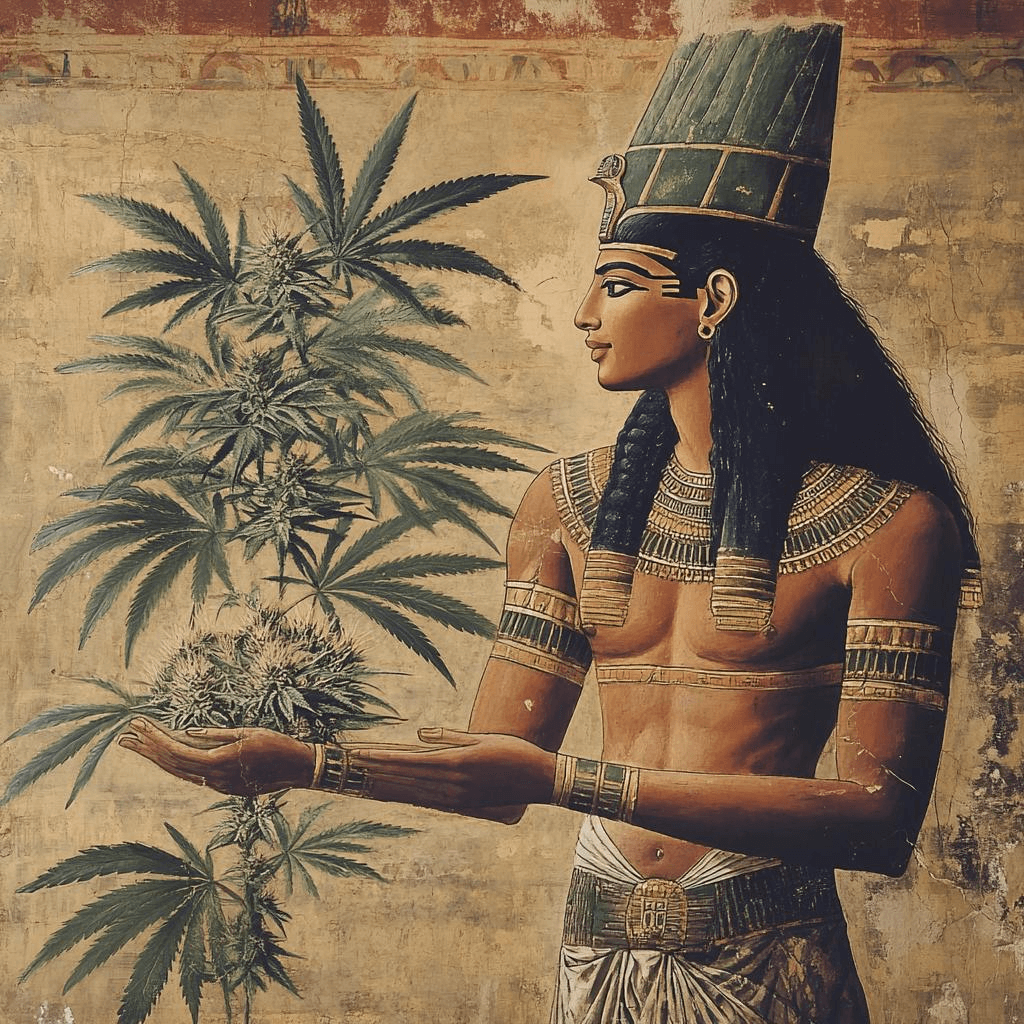The pyramids of Giza, the Sphinx, hieroglyphs, and mummies – these are the images that often come to mind when we think of ancient Egypt. But beyond the grandeur and mystery, this civilization also possessed a sophisticated understanding of medicine. Among their vast pharmacopeia was a humble plant with potent healing properties: cannabis.
While recreational cannabis use might be a modern phenomenon, the ancient Egyptians recognized and harnessed the therapeutic potential of this plant thousands of years ago. Let’s delve into the fascinating world of ancient Egyptian medicine and explore the role cannabis played in treating ailments and potentially even shaping religious practices.
Evidence from the Past:
Our knowledge of ancient Egyptian medicine comes primarily from surviving medical papyri, which are essentially ancient scrolls containing medical texts. These documents provide invaluable insights into the Egyptians’ understanding of the human body and their approaches to healing.
Several papyri mention a plant called “shemshemet,” which many scholars believe refers to cannabis. While not definitive, the descriptions and applications of shemshemet strongly align with the known properties of cannabis.
- The Ebers Papyrus (c. 1550 BC): One of the most extensive medical papyri, it mentions shemshemet as a treatment for various ailments, including inflammation, eye diseases, and gynecological conditions.
- The Berlin Papyrus (c. 1300 BC): This papyrus describes shemshemet as a remedy for fever and inflammation.
- The Ramesseum III Papyrus (c. 1150 BC): This document mentions shemshemet as an ingredient in a preparation used to treat glaucoma.
Beyond the papyri, archaeological evidence further supports the use of cannabis in ancient Egypt. Cannabis pollen has been found in tombs, including that of Ramesses II, one of Egypt’s most famous pharaohs. This suggests that cannabis may have also played a role in religious rituals or funerary practices.
Therapeutic Applications:
The ancient Egyptians were adept at utilizing plants for their medicinal properties, and cannabis was no exception. They employed various methods to administer cannabis, including:
- Topical Applications: Cannabis was likely ground into a paste or infused into oils and applied directly to the skin to treat inflammation, wounds, and skin diseases.
- Oral Ingestion: Cannabis may have been consumed orally in the form of teas or edibles to treat internal ailments.
- Fumigation: Burning cannabis and inhaling the smoke may have been used to treat respiratory conditions or induce relaxation.
Based on the papyri and other evidence, here are some of the conditions for which the ancient Egyptians likely used cannabis:
- Inflammation: Cannabis has well-known anti-inflammatory properties, and the Egyptians likely used it to treat a variety of inflammatory conditions.
- Pain Relief: Cannabis was probably used to alleviate pain, particularly menstrual cramps and headaches.
- Eye Diseases: The Ramesseum III Papyrus suggests that cannabis was used to treat glaucoma, a condition that can lead to blindness.
- Gynecological Conditions: The Ebers Papyrus mentions cannabis as a treatment for various gynecological problems, including menstrual cramps and inflammation.
- Fever: The Berlin Papyrus describes cannabis as a remedy for fever.
- Asthma and Respiratory Ailments: While not explicitly mentioned in the papyri, it’s possible that the Egyptians used cannabis to treat respiratory conditions, as it has bronchodilatory effects.
Cannabis and Spirituality:
While the primary use of cannabis in ancient Egypt appears to have been medicinal, there are hints that it may have also played a role in religious or spiritual practices. The presence of cannabis pollen in tombs suggests a possible association with funerary rites.
Some scholars have even proposed a connection between cannabis and Seshat, the ancient Egyptian goddess of writing and wisdom. Depictions of Seshat often show her with a seven-pointed star above her head, which some interpret as a stylized cannabis leaf. However, this interpretation remains speculative.
A Legacy of Healing:
The use of cannabis in ancient Egypt highlights the long and intertwined history of humans and this plant. The Egyptians’ knowledge of cannabis and its therapeutic applications demonstrates their advanced understanding of medicine and their ability to harness the power of nature for healing.
While much of the specific knowledge about ancient Egyptian cannabis use has been lost to time, the surviving evidence paints a picture of a civilization that recognized the value of this plant. As we continue to explore the therapeutic potential of cannabis today, it’s fascinating to look back at the ancient Egyptians who, thousands of years ago, were already pioneers in cannabis medicine.
Further Research and Speculation:
- More in-depth analysis of the papyri: Further research into the ancient medical texts could reveal more details about the specific ways cannabis was prepared and used.
- Archaeological investigations: Excavations of ancient Egyptian settlements and tombs could uncover more physical evidence of cannabis use, such as seeds, fibers, or tools used for processing the plant.
- Interdisciplinary studies: Combining the expertise of archaeologists, historians, and medical researchers could provide a more comprehensive understanding of the role of cannabis in ancient Egyptian society.
While our knowledge of cannabis use in ancient Egypt is still incomplete, the available evidence strongly suggests that this plant was an important part of their medical and possibly even spiritual practices. As we continue to rediscover the therapeutic potential of cannabis today, it’s humbling to recognize that we are building upon a legacy of knowledge that stretches back thousands of years to the time of the pharaohs.


